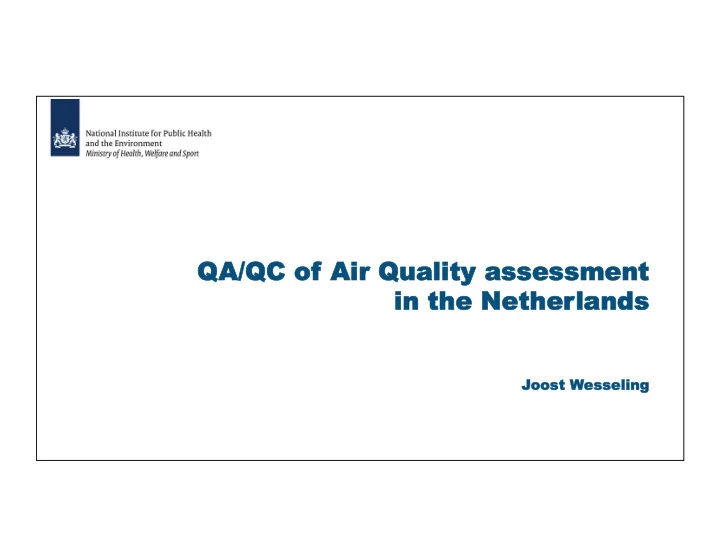

QA/QC QC of of Air ir Qualit Quality as asses essment ment in in the he Net Nether herlands lands Joos oost Wes esseling eling
The he Law Law Most formal rules concerning environmental issues are dealt in the Dutch law • on “Milieubeheer”, “Environmental Management”. • For air quality the underlying rules come from the Regulations and Directives from the EU. Many of the details of the Dutch law on air quality are regulated using • directives from the Minister of Infrastructure and Water Management. • For air quality the most important is the “Regulation air quality assessment, 2007”: the “Rbl 2007”. The present version was first published in 2007 and is updated (almost) every • year. RIVM provides technical reports with all relevant details. • RIVM QA/QC | FAIRMODE | Oct 2019 2
The he Rbl bl 2007: 2007: input inputs The “Rbl 2007” states which national emission factors, background • concentration fields, meteo fields (etc.) and calculation methods must be used in a formal assessment of air quality. It is possible to use different inputs, but then you need permission from the • minister, following advice from RIVM. The classification of the traffic in different emission categories is also prescribed • by law. The effects of different types of measures on traffic emissions must be • investigated and reported. They are open for criticism from others (RIVM). All traffic data must be made public. • • There is no differentiation of traffic emission factors over the country, all traffic is assumed to be relatively homogeneous. RIVM QA/QC | FAIRMODE | Oct 2019 3
The he system em All input/output for yearly official assessments are publicly available on the web. RIVM performs checks on all input and results and report the results to parliament. RIVM QA/QC | FAIRMODE | Oct 2019 4
The he Rbl bl 2007: 2007: met methods hods Three official calculation methods for air quality are officially used and allowed: • 1. Street canyons and general urban surroundings; 2. General large streets/highways without close-by building; 3. Industrial plants, general point sources Wind tunnel studies are also accepted, if in line with a protocol. • • It is possible to use different models/methods, but then you need permission from the minister, following advice from RIVM. RIVM has helped organize free available official tooling to perform calculations • using methods 1 and 2. • For method 3 a free version is also available. RIVM QA/QC | FAIRMODE | Oct 2019 5
Valida alidation ion Every few years RIVM collects the official data as well as • all indicative measurements performed by (mostly) municipalities. Locations around roads and at background locations. • Industrial sources are less well validated. • For all locations input is made for the appropriate official • calculation method(s). Most focus on NO2 à model is, on average, very close • to measurements, BIAS = +1.1, RMSE = 4.7 ug/m3. • For 98% of NO2 data the FAIRMODE MQI < 1.0 ( β =2). For PM10 and PM2.5: 99% and 100% (parameters?) • RIVM QA/QC | FAIRMODE | Oct 2019 6 µ µ µ µ
Impr mprovement ements? There is no legal obligation to correct for situations where the generic data are • not/less representative for the local situation. • In practice municipalities make a lot of effort to show the traffic in their region is cleaner than average. However, some municipalities clearly have traffic with higher than average • emissions, but they refuse to correct for that. As long as the city council does not object, this is possible. The minister dealing with the environment is reluctant to take action in cases like • this. • Composite mapping can stimulate more/better discussions between countries by show the (in)consistencies in official concentration fields ;-) RIVM QA/QC | FAIRMODE | Oct 2019 7
Ques Questions ions ? RIVM QA/QC | FAIRMODE | Oct 2019 8
Recommend
More recommend